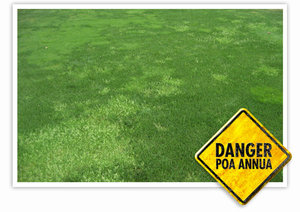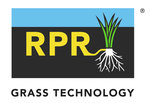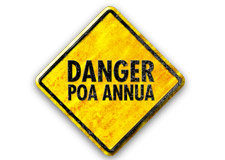Annual meadow grass makes sports fields unplayable

When light green patches appear on a sports field, the groundsman knows the score: annual meadow grass! If annual meadow grass is left to grow, it will become dominant in the field within three years. Newly laid out sports fields in particular are a target for annual meadow grass. Tackling it with chemicals is becoming more and more difficult, as some products are not easily available and the use of the number of permitted herbicides is becoming an increasingly greater issue. At Barenbrug we have researched Poa annua extensively in recent years, and we have succeeded in producing mixtures that are able to win the battle against annual meadow grass.
Temperature
 In practice, many fields are overseeded with a grass mixture that germinates at around 10 °C. The problem is that annual meadow grass germinates at 8 °C. Annual meadow grass grows extremely fast and that means that the sown or overseeded mixture stands no chance. Annual meadow grass is a real nightmare for the field manager. To control annual meadow grass, SOS from Barenbrug is an excellent choice. SOS germinates at low soil temperatures, even as low as around 4°C.
In practice, many fields are overseeded with a grass mixture that germinates at around 10 °C. The problem is that annual meadow grass germinates at 8 °C. Annual meadow grass grows extremely fast and that means that the sown or overseeded mixture stands no chance. Annual meadow grass is a real nightmare for the field manager. To control annual meadow grass, SOS from Barenbrug is an excellent choice. SOS germinates at low soil temperatures, even as low as around 4°C.
This is how SOS competes with annual meadow grass and when overseeding is done on a constant basis, it will make it virtually impossible for annual meadow grass to grow. At Barenbrug we use the so called growing degree days (=cumulative average day temperature). It is calculated after how many of these days a grass mixture or variety starts to germinate. This calculation shows that SOS needs fewer degree days compared to annual meadow grass.
Unfortunately, it also shows that annual meadow grass germinates much faster than, for example, English ryegrass. In order to be ahead of annual meadow grass, SOS is therefore the ideal overseeding mixture at low temperatures.
Annual meadow grass vs. SOS
 As mentioned before, SOS germinates at 4°C. In regard to the germination rate, it is therefore ahead of annual meadow grass which germinates at a soil temperature of 8 °C. If the choice is made to continue with annual meadow grass, it will soon become clear that annual meadow grass requires a lot of direct light. SOS needs light as well, but considerably less than annual meadow grass.
As mentioned before, SOS germinates at 4°C. In regard to the germination rate, it is therefore ahead of annual meadow grass which germinates at a soil temperature of 8 °C. If the choice is made to continue with annual meadow grass, it will soon become clear that annual meadow grass requires a lot of direct light. SOS needs light as well, but considerably less than annual meadow grass.
In terms of moisture and watering, the two grasses have a similar score. Annual meadow grass and SOS both need moisture. However, a problem of annual meadow grass is that if the moisture supply is interrupted for a while, it will find itself in a stress situation. Under stress, annual meadow grass will start to multiply itself very fast and is in fact unstoppable. On the other hand, when there is an excess of moisture, it will soon build a thick thatch layer. At a given time this layer will not allow water to pass through any more, which may lead to water problems. And lastly, annual meadow grass needs a large amount of nitrogen, whilst SOS needs a lot less.
For more information on SOS, click here.
Field top maker
If a field appears beyond repair, a field top maker can provide the solution. A field top maker is used for verticutting or removing the top layer of a sports field. Most of the annual meadow grass will be removed during the verticutting process, it is pulled out of the soil quickly because of its shallow roots. The advice is to follow up quickly with overseeding, using a suitable quality grass mixture.
There is also a more rigorous option: using the field top maker to remove the entire top layer. In this process all the grass is removed and taken away. The best mixture can then be selected to ensure that a beautifully dense grassed surface is created again as soon as possible. A good option for this purpose is RPR from Barenbrug.
RPR germinates very fast, whilst its horizontal stolons create a close-knit network in the turf. The plants are interconnected as it were, which ensures an extremely high level of strength. It greatly reduces the risk of damage to the grass and if this should occur at all, the self-regenerating nature of RPR will come to the fore. RPR creates such high density, that annual meadow grass will hardly get a chance to settle.
For more information on RPR, click here.
To maintain a sports field in a beautiful level state, it is important to overseed grass on a regular basis. When the game is over any bare patches will be clearly visible, and this is where overseeding can counter annual meadow grass. If you don’t do this, it is highly likely that annual meadow grass will occur everywhere and even take over the field. This grass presents a problem for golf courses, too.
For additional information, click here.
SOS is a great choice for overseeding during the winter months. When the temperature becomes higher, RPR is the best option. RPR forms horizontal stolons that create an entire network of very strong grass plants. Annual meadow grass may look good and green, but can have extremely undesirable consequences that may eventually make a sports field unplayable.
For more information on SOS, click here.




